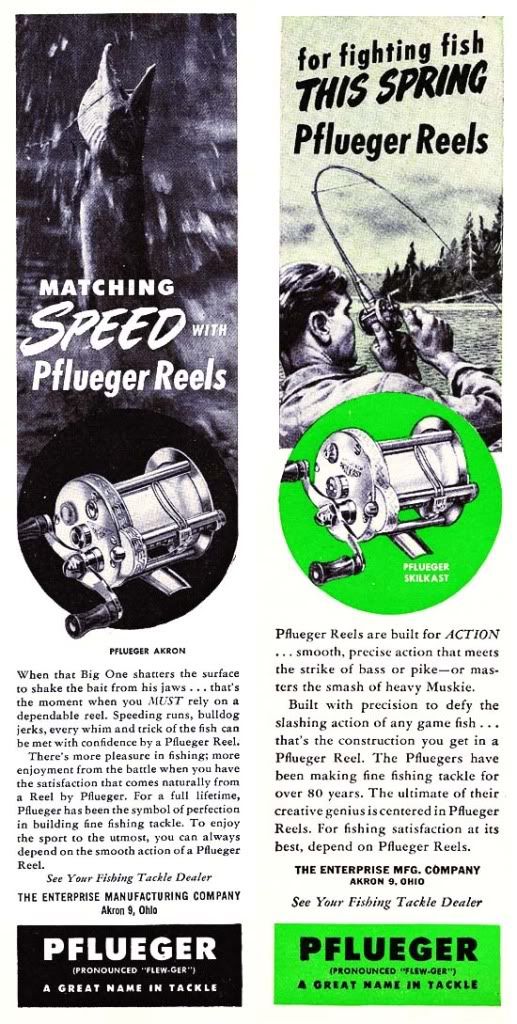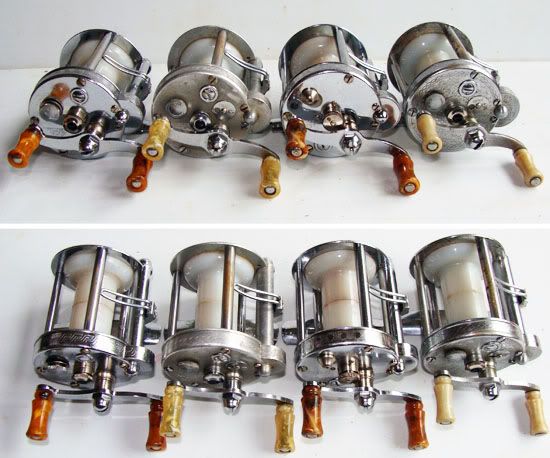Those Plastic Spooled Pflueger Reels
The first time I can remember seeing a Pflueger baitcasting reel with a white plastic spool was a Summit model at a garage sale about 35 years ago. My first thought was that this must have been a way to cheapen the cost of making a reel toward the end of its production run. Occasionally after that I would see Summits, Nobbys, Skilkasts, and Akrons with the plastic spool. I always passed on them as they seemed something less of a reel. I enjoy using older baitcasting reels and have tried to use the best quality reel produced during a model's lifetime and plastic spools didn't seem to fit this mold.
After I became familiar with the evolution of these reels and the changes they had gone through, it became obvious that the plastic spools did not occur at the end of their production run, but rather much earlier. No one seemed to know when, what or why these plastic spools existed and they were not shown or described in any Pflueger catalog.
As I was looking at a plastic spooled Summit in the box at a lure show, it occurred to me that almost all Pflueger reels have an inspection date stamped on the bottom of the box indicating when they left the factory. I turned the box over and saw a 1948 date. That was a start. In order to check the accuracy of that combination (box & plastic spooled reel) I began to check each and every one I saw. Over the next several years anytime one came up on eBay that looked like it probably was in the original box I would ask the seller for the date stamped on the bottom. The answer always came back sometime in 1948. I have seen one box that was dated the last day in November 1947.
Sometime later I ran across the following ads which show, but do not mention, the plastic spool. The ad for the Akron is from the April 1948 issue of Outdoor Life and the SkilKast ad is from the March 1948 issue of Sports Afield.

The two obvious questions that fallow are: Why would Pflueger go to an all plastic spool? --- and why did they give up on it so quickly? There was a lively discussion about this topic some time back on the Old Reel Collector Association website. My own feeling is that it has more to do with the history of line than anything else. Pflueger had always used cork arbors on their baitcasting reels. Before World War II almost all braided casting lines were silk. A dry silk casting line has very little stretch in it and it must be removed from the reel and dried after each use or it will quickly mildew and rot. After World War II the new “wonder material” DuPont Nylon quickly took over the braided casting line market, if for no other reason than it did not need to be dried after each use and seemed impervious to decay. There was a problem with early braided Nylon line. It would stretch approximately one third of its length before breaking and one fourth of its length under even moderate tension. In addition to making it somewhat difficult to set the hook on a fish, it had the same effect as wrapping a long strand of rubber band on the spool. As each addition layer of line was wound onto the spool under tension, the ever increasing crushing force soon warped the soft cork arbor out of round and made casting uncomfortable at best. Plastic was a “modern” product that was viewed as the answer to many problems. (It was even used to stock shotguns at this time!) It seemed an obvious answer to this problem. It would not deform under pressure like cork. It was light and eliminated the need for an arbor as that was already part of the molded spool. Why did the plastic spool stick around such a short time? No one is sure. My best guess is that the public did not like the idea and the line companies by 1949 had made great strides in reducing the amount of stretch in Nylon casting lines. This is documented in several books. If interested, I particularly recommend the chapter on lines in John Alden Knight's 1949 book Black Bass. Also the permanent, molded arbor on the plastic spool reduced the line capacity of the spool. This would have been a big disadvantage in situations like Musky fishing where more than 50 yards of line would be prudent.
There is another possible factor. I do a lot of repair and casting with baitcasting reels of the pre-1960 period. I have made it a point to try several examples of Summits, Nobbys and Skilkasts with plastic spools. They cast moderately well but never quit as well as the same reels with aluminum spools. Surprisingly, most are also somewhat more noisy. Later, Pflueger did produce a snap-on, white plastic arbor which never seemed to replace the ever-present cork. I personally like the plastic Pflueger arbor but due to some apparent miscalculations in design the arbor pin never wants to line up correctly with the line tie hole in the spool. This may explain why the Pflueger plastic snap-on arbors are so hard to find.


-- Bill Sonnett
No comments:
Post a Comment